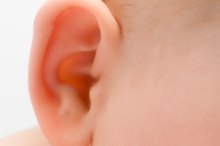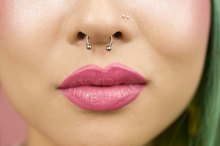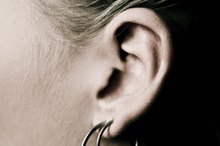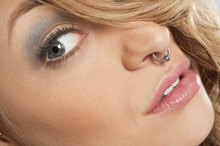Aftercare Instructions for Navel Piercing
Navel piercings are popular, but they can also be dangerous. The American Academy of Family Physicians warns that hypertrophic scarring and infection can derail your efforts for a trendy belly button 1. Aftercare is of the utmost importance. Proper care, washing and healing will go a long way toward ensuring that you have a healthy navel piercing. The right tools and the right techniques could mean the difference between clean healing and a messy infection and subsequent scarring.
Ask the piercer who performed your piercing for a saline solution. Most piercers sell them, or you can purchase one from a jewelry store or drugstore. After the initial piercing, you may notice a crusty discharge. Instead of peeling it away and aggravating the healing process, use saline solution to gently dissolve the discharge and leave your navel looking clean and healthy. Just apply the solution with gauze dipped in warm water until the discharge is gone.
Isopropyl Alcohol for Dry Ears
Learn More
Wash your piercing twice a day using an antibacterial soap. Just apply a few drops of soap onto your fingers, work up a lather and gently wash around the piercing with your hands. Avoid using abrasive materials like a scrub or loofah, which can irritate the sensitive skin. Gently pat the area dry with gauze. Never wash the piercing more than twice a day, or you'll risk disrupting the healing process.
Wear loose clothing that allows plenty of air to get to the healing site, recommends the American Academy of Family Physicians 1. Tight clothing can hinder healing by introducing sweat and bacteria into the piercing, resulting in infection. Tight clothes can also cause friction and irritation of the sensitive skin around the piercing site.
How to Prevent Infection in Pierced Ears
Learn More
Avoid swimming in public pools or using public hot tubs. Water-borne bacteria may enter the piercing site. The Center for Young Women's Health, a division of Children's Hospital Boston, notes that if you plan on using public pools or hot tubs, you ahould cover your piercing temporarily with a waterproof bandage 2.
Allow your piercing to get as much air as possible. Never apply antibacterial ointments to your piercing, which could actually trap bacteria inside and prolong the healing process. You should also avoid any excessive touching of the ring. While you may be excited to show it off, wait until the piercing has healed to change rings or to show the piercing to your friends who may want to touch.
Related Articles
References
- American Academy of Family Physicians: Complications of Body Piercing
- Young Women's Health: Body Piercing
- Holbrook J, Minocha J, Laumann A. Body piercing: complications and prevention of health risks. Am J Clin Dermatol. 2012;13(1):1-17. doi:10.2165/11593220-000000000-00000
- University of Michigan. Body art: What you need to know before getting a tattoo or piercing. University Health Service. 2019.
- Meltzer DI. Complications of body piercing. Am Fam Physician. 2005;72(10):2029-2034.
- Antoszewski B, Jedrzejczak M, Kruk-Jeromin J. Complications after body piercing in patient suffering from type 1 diabetes mellitus. Int J Dermatol. 2007;46(12):1250-1252. doi:10.1111/j.1365-4632.2007.03372.x
- Madu P, Kundu RV. Follicular and scarring disorders in skin of color: presentation and management. Am J Clin Dermatol. 2014;15(4):307-321. doi:10.1007/s40257-014-0072-x
- Weber, Angela. "Evaluation of Potential Bloodborne Pathogen." (PDF) Feb 2001. Centers for Disease Control and Prevention.
Writer Bio
Kay Ireland specializes in health, fitness and lifestyle topics. She is a support worker in the neonatal intensive care and antepartum units of her local hospital and recently became a certified group fitness instructor.









